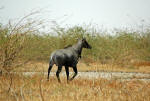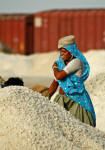Little Rann of Kutch, Gujarat, India (map)
The Rann of Kutch, an area of 18,000 sq km, lies almost entirely within Gujarat along the border with Pakistan. The Little Rann of Kutch extends northeast from the Gulf of Kutch over 5,100 sq km. Once an extension of the Arabian Sea, the Rann ("salt marsh") has been closed off by centuries of silting. During Alexander's time it was a navigable lake, but is now an extensive mudflat, inundated during the monsoons, salty and cracked otherwise. Settlement is limited to low, isolated hills. [Adapted from Encyclopedia Britannica]
When I visited the Rann in April, 2006, the highs were already soaring past 110 F. The best way to see it, as I did, is in a 4WD stocked with lots of water. Dotting the parched landscape are desolate desert-like encampments, where a family or two combine forces to eke out a living by mining salt from the saline ground water, the biggest local industry. Legend has it that even after a salt worker dies and is cremated, the soles of his feet survive - a lifetime of labor in the salt pans bakes them so hard that even fire cannot fully burn them.* Tata lorries transport their salt to small trading villages along a railway line. In the dry season, such villages host veritable hillocks of salt as far as the eye can see, where it's packed and sent out on trains.
Kutch is also home to numerous tribal groups, whose attire often adds a dash of color to the otherwise dull desert monotones. Many, such as the Rabari, are still nomadic and semi-nomadic pastoralists (these photos only show women, children, and older men with the camels; the younger men were out tending their sheep and would converge in the evening at a designated place, where the women would setup the tents and cook).
In the monsoons, parts of the Rann fill up with seasonal brackish water and some locals harvest shrimp in it. They abandon their boats afterwards in the barren salty mudflats, creating a rather surreal scene for the spring/summer-time visitor. Heat mirages abound, making distant objects hover strangely above the land. The Little Rann is also a wildlife sanctuary that protects the Asiatic wild ass, a shy and handsome animal that can sprint at 70 km/h. Down to about 2,800 in number, they depend on the few grassy islands, or bets, nourished by monsoon rains. The sanctuary also contains a large number of local and migratory birds, especially flamingos, at its many wetlands. A memorable experience was to go wading knee-deep into the warm waters of a salt marsh with thousands of flamingos around.
[- Post/see comments on my Rann of Kutch blog post]
Saline mudflats (more)  |
 |
 |
Gujarati bride (more)  |
 |
 |
||
 |
 |
||
 |
Cracked earth  |
 |
Local transportation  |
Wetland bird  |
Landscape (more)  |
||
Desert mirage  |
Khur  |
||
 |
 |
Dragonfly  |
Rann visitor  |
Cattle in a wetland  |
 |
Fishing boats in the desert?!  |
 |
Train to Bhuj  |
Buffalo meal  |
 |
Full moon night  |
| The Salt People of the Little Rann of Kutch |
|||
 |
Salt workers (more)  |
Mounds of salt  |
Salt worker dwelling  |
Salt worker  |
Salt worker  |
 |
Woman and children  |
Salt pan (crystals)  |
Fields of salt  |
Salt water pump  |
Crossing the mudflat  |
| Article in Frontline: Bounties of a bleak landscape | |||
Designed in collaboration with Vitalect, Inc. All rights reserved. |








